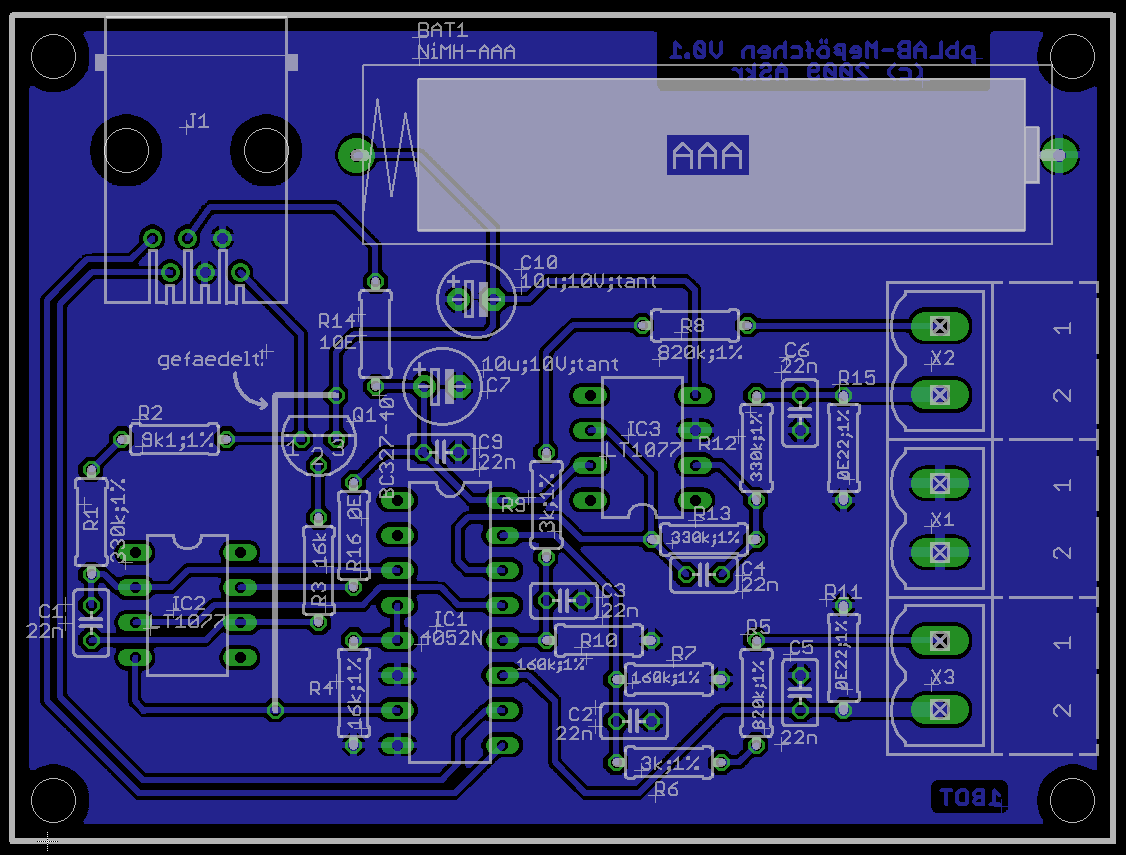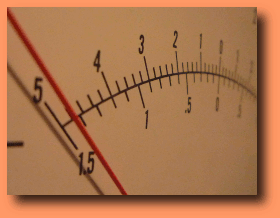pbLab-Messoefchen
A quick and dirty efficiency-meter for non-insolated switching regulators. pbLua featured.
Features:
- 0-30V @ 30mV resolution
- 0-1A @ 1mA resolution
- minimal components (well, at least I think so...)
- uses NXT's internal A/D converters
- fully pbLua powered (what else? ;-)
- requires only one port
- still needs one AAA battery (0.9 - 1.5V)
- ...
Note 03/2010: Preliminary/Experimental...
Time to revive some older projects on the new pages.
I created a set of new documents and a layout for the wirewrapped, 2008-prototype version...
One day I was sitting at work, trying to squeeze out the last percent of efficiency (and costs) out of a low power
buck-regulator. Because of the wide input voltage- and current output-range, I had 4 multimeters attached, constantly
reading their voltages and currents, hacking everything into a spreadsheet or a calculator. On every change in the
circuit (mainly testing coils and feedback loops), I did the same again and again and again...
What a waste of time...
That day back at home, I browsed through several boxes of once developed electronics, I knew I had some
appropriate stuff laying around there somewhere...
Suddenly, a NXT felt into my hands. Mhh, what about something new and using this one?
It's small, battery powered, comes with up to 4 A/D converters (though they require special input circuitry),
some buttons and a display...
Perfect!
I sat down, calculated and began to build this...
The next day, back at work, measuring a complete curve (e.g. Vin to efficiency, Iout to efficiency, ...) took
only 10 seconds...
---
Don't miss Messofen, its successor ;-)
A NOTE ON SAFETY: Never ever must this device be connected to AC mains,
any equipment containing mains power supply or a voltage >42DC!
Hardware
the circuit...
|
...and a little test-layout
|
The two original regulator circuits, for which this little toy was invented within a few hours, were
- 18-30V to 2.0-3.3V, 100mA
- 42V to 6-7V, 200mA (*2*)
(*2*) Note: The circuit, as presented here, was redesigned for a maximum of ~30V!
I was short on time, so I decided to take the easy way and put the current measurement into the low rail.
The above schematic contains the circuit of Messoefchen as well as its attachment to the switching regulator (or vice versa).
The NXT ground is the ground of the regulator (X1-1,2).
Two resistor dividers (U1M, U2M) measure the input and output voltages of the regulator.
The output current is measured via the shunt resistor R11.
The input current is measured via the shunt resistor R16, which will create a negative voltage drop with respect to ground.
IC3, configured as an inverting amplifier, with a gain of 1 (or "-1", if you prefer this notation), corrects this.
Because the NXT has no negative voltage supply and another regulator would have been to much work for this night,
a battery was chosen instead. Even an empty NiMH cell (~0.8V) is sufficient to power this circuit.
The 4 measurands (in and out, voltage and current) are fed to a 4052 multiplexer, which selects one of the measurements, controlled by NXTs dig0 and dig1 (J1 5,6).
The two voltage channels (4052, X0 and X2), pass IC2 as an impedance converter (and NXT pin1 10k killer ;-), with a gain of 1.
If a current is selected (4052, X1 or X3), R4 is chained into the feedback loop of IC2 (4052 Y1 or Y3), resulting in an amplification factor of ~22.2.
If you wonder about the additional transistor Q1 at the output, read this and scroll down a little...
Beside the fact that the NXT's A/D converter is not a precision instrument, Messoefchen, as presented here, has the following resolutions:
- 30mV per digit on channel 0 and 2 (4052 X0, X2); max of ~30.7V(!)
- 1mA per digit on channel 1 and 3 (4052 X1, X3); max of ~1.02A(!)
While Messoefchen's precision is quite good and can be <<1% (assuming selected components), a software calibration might be required (because of the NXT's internal A/D converter and voltage supply).
If you decide to perform a calibration, choose either 3/4 of the maximum voltage (~23V) for a general approach, or temporarily tune it to your application...
Software
to be uploaded...
Download
pbLab-Messoefchen:
Includes:
- schematic (PDF)
- placement (PDF)
- layout, eagle (BRD)
DOWNLOAD: pblab-messoefchen_V01-hard.zip 3/3010 (V0.1, nicely drawn)
ASkr 12/2008 initial wirewrapped version (V0.09)
ASkr 03/2010 upgrade to V0.1 (...) and a nicer set of documents

